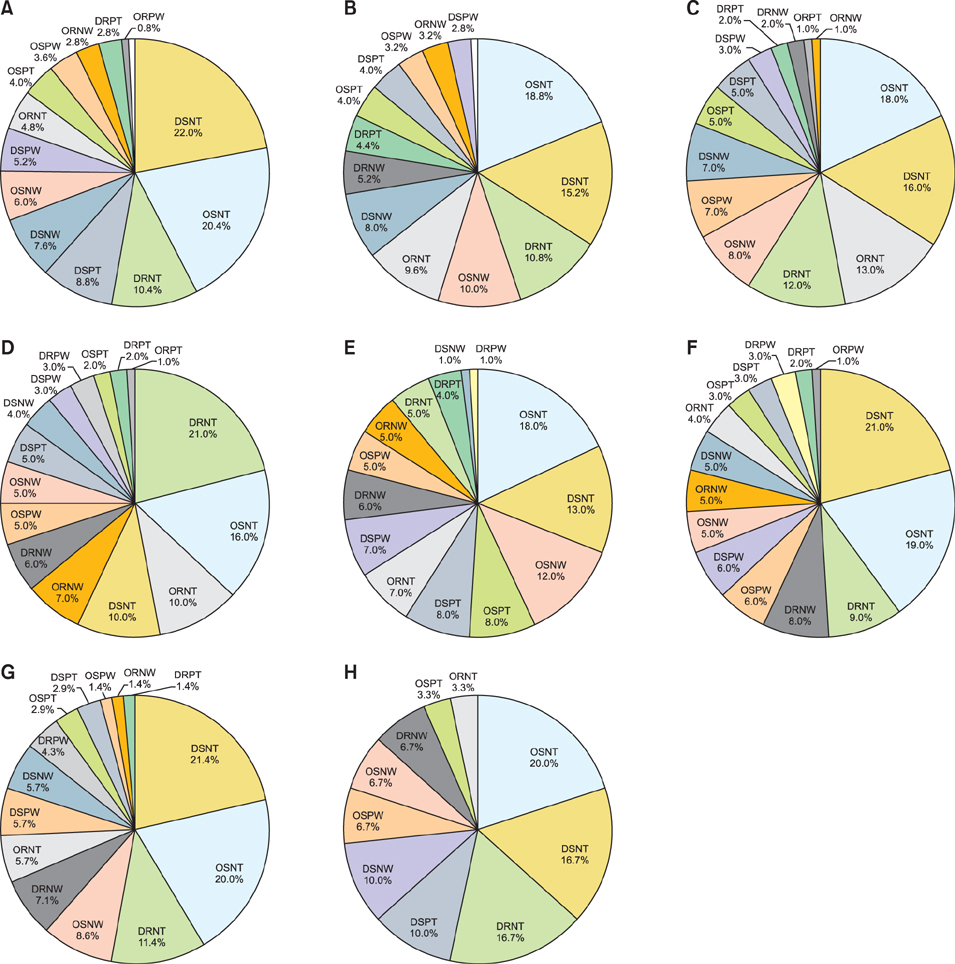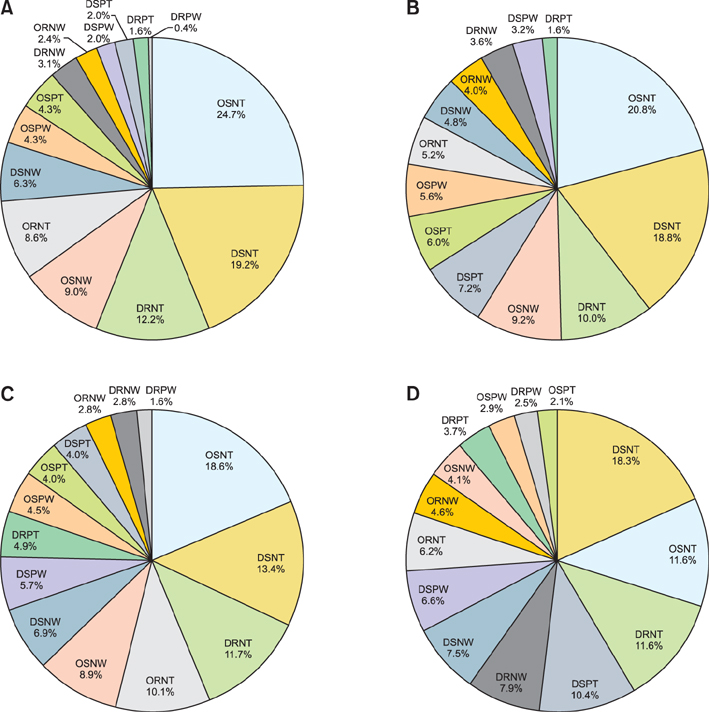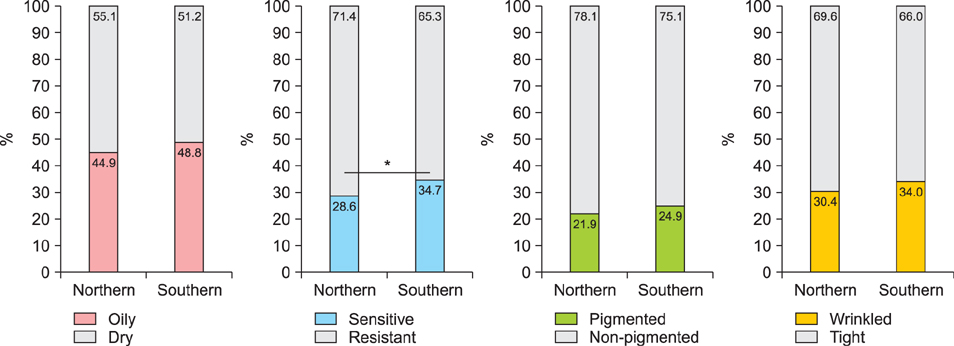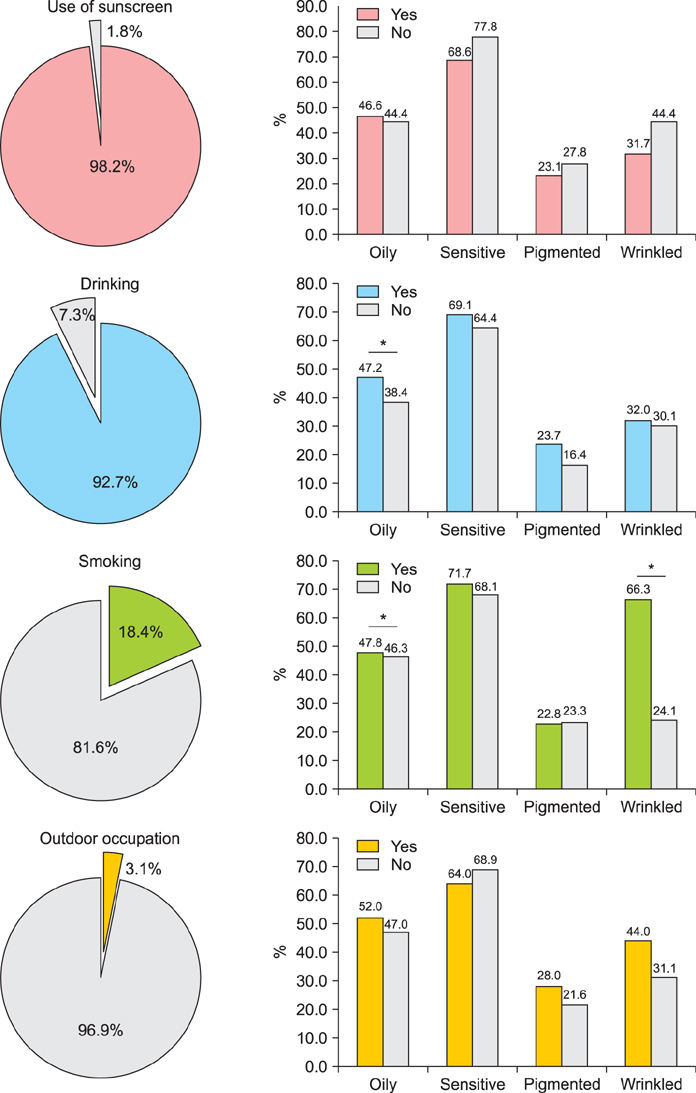Ann Dermatol.
2017 Oct;29(5):586-596. 10.5021/ad.2017.29.5.586.
Baumann Skin Type in the Korean Female Population
- Affiliations
-
- 1Department of Dermatology, Yonsei University Wonju College of Medicine, Wonju, Korea. ahnsk@yonsei.ac.kr
- 2Neopharm Co., Ltd., Daejeon, Korea.
- 3Department of Dermatology, Dankook University Medical College, Cheonan, Korea.
- 4Department of Dermatology, Soonchunhyang University College of Medicine, Seoul, Korea.
- 5Department of Dermatology, Chonnam National University Medical School, Gwangju, Korea.
- 6Department of Dermatology, Yonsei University College of Medicine, Seoul, Korea.
- 7Department of Dermatology, Kyungpook National University School of Medicine, Daegu, Korea.
- 8Department of Dermatology, Pusan National University School of Medicine, Busan, Korea.
- 9Department of Dermatology, Wonkwang University School of Medicine, Iksan, Korea.
- KMID: 2388910
- DOI: http://doi.org/10.5021/ad.2017.29.5.586
Abstract
- BACKGROUND
To meet the need for a subspecialized skin type system, the Baumann skin type (BST) system was proposed.
OBJECTIVE
To evaluate the distribution of BST types and influencing factors among Korean women.
METHODS
BST questionnaires were administered to 1,000 Korean women. The possible responses were as follows: oily (O) or dry (D), sensitive (S) or resistant (R), pigmented (P) or non-pigmented (N), and wrinkled (W) or tight (T). The correlations of the BST with the subjects' age, location, ultraviolet (UV) ray exposure, drinking and smoking habits, and blood type were assessed.
RESULTS
The OSNT, DSNT, DRNT, and OSNW skin types were the most common skin types (55.3%). The O, S, P, and W types accounted for 46.6%, 68.8%, 23.2%, and 31.9%, respectively. The proportion of the O and S type was the highest in Gyeongsangbuk-do (55.0%) and Seoul (77.2%). The proportion of the P and W type was the highest in Gyeongsangbuk-do (33.0%) and Chungcheong-do (39.0%). The O type decreased in the higher age group, whereas the P and W type showed a reversed tendency. In smokers, the proportion of W type was significantly higher than in the non-smokers (66.3% vs. 24.1%, p<0.05).
CONCLUSION
The 4 most common BST types were OSNT, DSNT, DRNT, and OSNW. In the comparison across the 4 BST parameters according to the age, region, smoking and drinking habits, occupation, blood type, and UV exposure, significant differences were observed. Individualized and customized skin care is required according to the personal skin type.
MeSH Terms
Figure
Cited by 1 articles
-
Baumann Skin Type in the Korean Male Population
Young Bin Lee, Sung Ku Ahn, Gun Young Ahn, Hana Bak, Seung Phil Hong, Eun Jung Go, Chang Ook Park, Sang Eun Lee, Weon Ju Lee, Hyun-Chang Ko, Jee-Bum Lee, Hyung Joo Kim, Kun Park, Sang-Hoon Lee, Dong Hoon Song, Sun Young Choi, Yeol Oh Sung, Tae-Hyun Kim, Ja Woong Goo
Ann Dermatol. 2019;31(6):621-630. doi: 10.5021/ad.2019.31.6.621.
Reference
-
1. Baumann L. The skin type solution: a revolutionary guide to your best skin ever. New York: Bantam Books;2006. p. 4–26.2. Roberts WE. Skin type classification systems old and new. Dermatol Clin. 2009; 27:529–533. viii
Article3. Fitzpatrick TB. The validity and practicality of sun-reactive skin types I through VI. Arch Dermatol. 1988; 124:869–871.
Article4. Youn JI, Choe YB, Park SB, Suh DH, Park YK, Ahn SK, et al. The Fitzpatrick skin type in Korean people. Korean J Dermatol. 2000; 38:920–927.5. Kawada A. UVB-induced erythema, delayed tanning, and UVA-induced immediate tanning in Japanese skin. Photodermatol. 1986; 3:327–333.6. Glogau RG, Matarasso SL. Chemical peels. Trichloroacetic acid and phenol. Dermatol Clin. 1995; 13:263–276.
Article7. Lancer HA. Lancer Ethnicity Scale (LES). Lasers Surg Med. 1998; 22:9.
Article8. Fanous N. A new patient classification for laser resurfacing and peels: predicting responses, risks, and results. Aesthetic Plast Surg. 2002; 26:99–104.
Article9. Goldman MP. Universal classification of skin type. In : Shiffman MA, Mirrafati SJ, Lam SM, Cueteaux CG, editors. Simplified facial rejuvenation. Berlin: Springer Berlin Heidelberg;2008. p. 47–50.10. Taylor S, Westerhof W, Im S, Lim J. Noninvasive techniques for the evaluation of skin color. J Am Acad Dermatol. 2006; 54:5 Suppl 2. S282–S290.
Article11. Kim YS, Park KS, Kang SK. Relationship between occupational quality and skin type through Dr. Baumann’s skin analysis. J Korean Soc Cosmetol. 2008; 14:589–594.12. Baumann L. Cosmeceuticals and cosmetic ingredients. New York: McGraw-Hill Education;2015. p. 1–18.13. Youn SW, Park KC. Measurements of facial sebum secretion and facial skin type considering sebum secretion. J Cosmet Dermatol. 2006; 3:5–10.14. Kim CS, Chun IK, Kim YP. A study of skin surface lipids analysis of the Koreans. Korean J Dermatol. 1992; 30:1–7.15. Lee SH, Lee SE, Ahn SK, Hong SP, Kim HJ, Lee HK, et al. Skin barrier. Seoul: Ryo Moon Gak;210. p. 279–290.16. Draelos ZD. Sensitive skin: perceptions, evaluation, and treatment. Am J Contact Dermat. 1997; 8:67–78.
Article17. Ryu HS, Kim DW, Lee SJ, Na GY, Chung SL. Statistical observation of sensitive skin and evaluation of subjective irritation using lactic acid sting test. Korean J Dermatol. 2002; 40:874–885.18. Farage MA. How do perceptions of sensitive skin differ at different anatomical sites? An epidemiological study. Clin Exp Dermatol. 2009; 34:e521–e530.
Article19. Chung JH, Koh WS, Youn JI. Relevance of skin phototyping to a Korean population. Clin Exp Dermatol. 1994; 19:476–478.
Article20. Fioletov V, Kerr JB, Fergusson A. The UV index: definition, distribution and factors affecting it. Can J Public Health. 2010; 101:I5–I9.
Article
- Full Text Links
- Actions
-
Cited
- CITED
-
- Close
- Share
- Similar articles
-
- Identifying Skin Type using the Baumann Skin Type Questionnaire in Korean Women Who Visited a Dermatologic Clinic
- Which Skin Type Is Prevalent in Korean Post-Adolescent Acne Patients?: A Pilot Study Using the Baumann Skin Type Indicator
- Baumann Skin Type in the Korean Male Population
- Treatment of Displaced Flexion Type Supracondylar Fractures of the Humerus in Children: Comparison with Extension Type
- The Normal Humero-Capitellar Angle in Children ; Baumann Angle and Lateral Humero-Capitellar Angle







